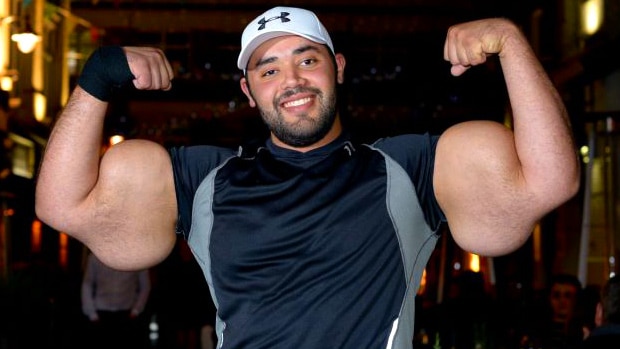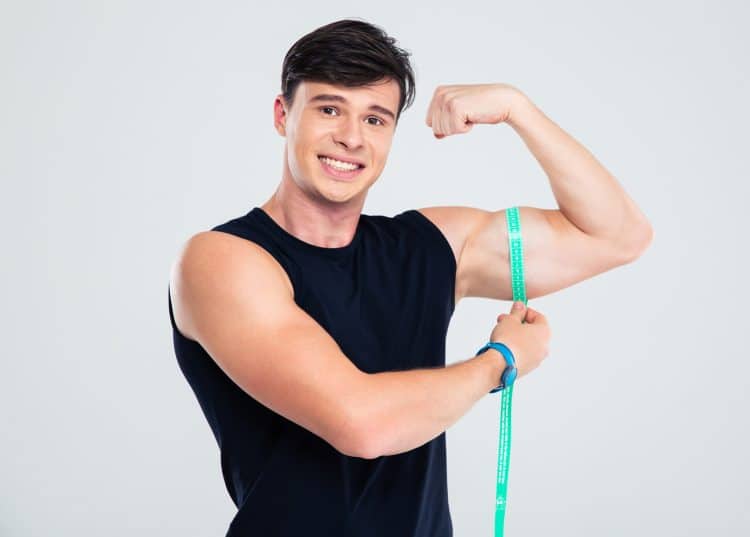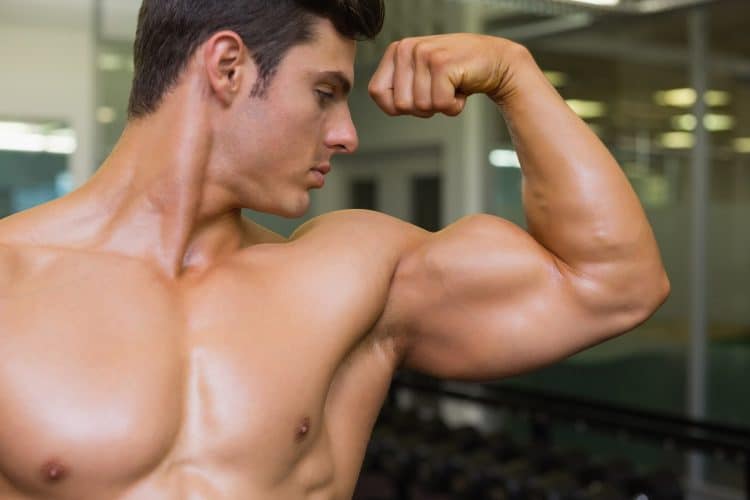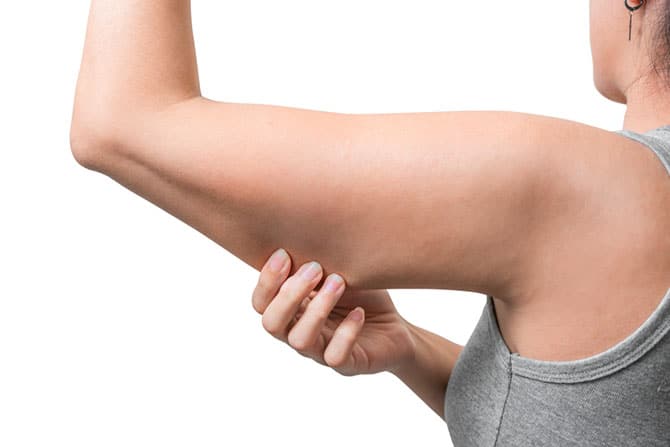Everyone who lifts weights has at least a passing interest in the size of their biceps. The biceps is the most famous muscle in the human body, and even non-exercisers can identify them.
Big biceps really capture the imagination. So much so that a lot of exercisers dedicate an inordinate amount of time building the ultimate arms.
Some people go so far as to inject noxious oil into their biceps to make them bigger. We’re not talking steroids but substances that cause inflammation and swelling. Needless to say, that’s not an approach we recommend!

Instead, we recommend you train your arms as part of a balanced bodybuilding workout. Remember, too, that your triceps actually make up more upper arm mass than your biceps, so if you want bigger arms, train your bis and tris equally.
That said, a lot of people want to know how their biceps measure up against the average arm circumference. Are your biceps too big (impossible!), too small, or just right?
Level Up Your Fitness: Join our 💪 strong community in Fitness Volt Newsletter. Get daily inspiration, expert-backed workouts, nutrition tips, the latest in strength sports, and the support you need to reach your goals. Subscribe for free!
While the ideal biceps size is clearly objective, we can tell you how your arms compare to the average for your age.
How To Measure Your Biceps
Before we start comparing biceps size (yours are probably bigger, right!?), we need to standardize how we’re going to measure our biceps.
Firstly, make sure your biceps and triceps are “cold,” i.e., not pumped full of blood from your recent workout.
Then, decide if you’re going to measure your arms straight or flexed. Straight is probably more accurate but flexed is better for your ego. The average biceps measurements outlined below are for relaxed biceps. So, if you are interested in making a comparison, make sure you also take a relaxed measurement.
Finally, ask a friend to measure your arms for you. It’ll be a) easier and b) more likely to result in an accurate measurement. There is less chance of any creative “rounding up” that would inflate your measurement.
Ready? Grab your tape measure…
To measure your relaxed biceps
- Stand up straight with your arms relaxed at your sides.
- Measure around the mid-point of your arm, which is halfway between your elbow (olecranon) and the tip of your shoulder (acromion process). This will also probably be the thickest part of your arm.
- Measure your left and right arms to see if there is a difference.
- Record your results.
To measure your flexed biceps
- Sit at a table and rest your arm on the tabletop.
- Make a fist. Curl your forearm up toward your shoulder as if doing a bicep curl. Flex your arm as hard as you can.
- Measure the circumference of your arm with the tape measure passing over the highest point of your biceps. As before, measure both arms to check for left to right differences.
- Record your results.
Average Biceps Size By Age (Male & Female)
Average arm circumference tends to decrease with age. That’s because muscle mass usually peaks when you are in your mid-30s and decreases gradually after that. Most people lose around ten pounds of muscle per decade unless they follow a rigorous strength training regimen and eat healthily.
Average Biceps Male:
According to the CDC (Centers for Disease Control), the average arm measurement for men by age is (1):
| Age | Average Biceps Size in inches (cm) |
| 20–29 | 13.3 inches (33.78 cm) |
| 30–39 | 13.8 inches (35.05 cm) |
| 40–49 | 13.9 inches (35.30 cm) |
| 50–59 | 13.5 inches (34.29 cm) |
| 60–69 | 13.4 inches (34.04 cm) |
| 70–79 | 12.9 inches (32.77 cm) |
| 80+ | 12.1 inches (30.73 cm) |
Average Biceps Female:
And these are the average arm measurements for women, who tend to be less muscular than most men (1):
| Age | Average Biceps Size in inches (cm) |
| 20–29 | 12.4 inches (31.50 cm) |
| 30–39 | 12.9 inches (32.77 cm) |
| 40–49 | 12.9 inches (32.77 cm) |
| 50–59 | 12.9 inches (32.77 cm) |
| 60–69 | 12.7 inches (32.26 cm) |
| 70–79 | 12.6 inches (31.99 cm) |
| 80+ | 11.4 inches (28.96 cm) |
Is There a Connection Between Height and Biceps Size?
In short, no; height isn’t a reliable indicator of biceps size. Now, let’s delve into the details.
A more accurate relationship to consider when determining biceps size is wrist circumference. It’s much more likely that someone with thicker wrists will also have bigger biceps, regardless of their height. As such, a tall and skinny individual may not necessarily have larger biceps than someone shorter with thicker wrists.
Biceps Size: What’s Considered Big?
Determining “big” biceps can be subjective and depends on factors like height, weight, and overall body composition. That said, here’s a general guideline to put things in perspective: biceps measuring around 16-17 inches (41-43 cm) in circumference are often seen as substantial for an average-sized man. Remember, this is merely a rough estimate, and perceptions of “big” can vary significantly from person to person.
Men:
- 11-12 inches (28-30cm): On the smaller side, it might be time to focus on gaining mass.
- 12-14 inches (30-35cm): Average size, but there’s still room for improvement.
- 14-16 inches (35-41cm): Looking muscular; you’re well on your way to eye-catching arms.
- 16-18 inches (41-46cm): Clearly strong; it’s evident you hit the gym.
- 18-20 inches (46-51cm): Joining the elite; welcome to the gun show, my friend.
- 20+ inches (51cm+): A true behemoth, making the rest of us feel a tad weak.
Women:
- 10-11 inches (25-28cm): A bit on the skinny side; time to increase your calorie intake.
- 12-13 inches (30-33cm): Average size; keep up the good work.
- 14-16 inches (35-41cm): Larger than most of your peers, including men; definitely turning heads.
- 16-18 inches (41-46cm): Impressively built; people might mistake you for a bodybuilder.
- 18-20 inches (46-51cm): Breaking new ground, armed and ready to shatter records.
Please note that the above ranges assume you’re not excessively overweight and that muscle mass predominantly contributes to your upper arm size.
What About Bodybuilders’ Biceps Size?
For decades, the bodybuilding community has considered the 20-inch biceps as a sought-after benchmark. But, as you’ll see below, some female bodybuilders are edging closer to this impressive goal! Here are a few noteworthy examples of bodybuilders and their biceps sizes during their prime:
Level Up Your Fitness: Join our 💪 strong community in Fitness Volt Newsletter. Get daily inspiration, expert-backed workouts, nutrition tips, the latest in strength sports, and the support you need to reach your goals. Subscribe for free!
- Ronnie Coleman: 24 inches (60.96 cm)
- Phil Heath: 23 inches (58.42 cm)
- Flex Lewis: 22 inches (55.88 cm)
- Kai Greene: 22 inches (55.88 cm)
- Roelly Winklaar: 24 inches (60.96 cm)
- Lee Priest: 22 inches (55.88 cm)
- Bill Pettis: 23.25 inches (59.06 cm)
- Flex Wheeler: 24 inches (60.96 cm)
- Arnold Schwarzenegger: 22 inches (55.88 cm)
- Chris Bumstead: 22 inches (55.88 cm)
- Iris Floyd Kyle (Female): 17 inches (43.18 cm)
- Andrea Shaw (Female): 17 inches (45.72 cm)
Related: Top 12 Bodybuilders with the Biggest Biceps in the World
Are Biceps Hard to Grow?
When it comes to developing those enviable biceps, it’s not necessarily an uphill battle.
When it comes to developing those enviable biceps, rest assured it’s not an insurmountable challenge. By adhering to the progressive overload principle, maintaining proper nutrition, and employing effective training techniques, you can achieve noteworthy biceps growth.
However, it’s important to remember that although they may seem more challenging to develop, biceps should grow at a similar rate as other muscles. The key difference is that biceps are smaller muscles compared to larger ones like glutes or quads, so it might take longer to observe noticeable changes in size.
Why Your Biceps Aren’t Growing?
There could be a myriad of reasons your biceps are lagging, such as incorrect training methods, overexertion, or an unsuitable diet. All too often, individuals place excessive emphasis on growing their biceps, inadvertently leading to overtraining.
Remember that biceps are engaged in numerous pulling exercises like bent-over rows, lat pulldowns, and pull-ups. If you heap on a plethora of additional biceps isolation exercises, you could be robbing your muscles of essential recovery time.
To boost your biceps growth, consider altering training variables such as volume, body positioning, grip, and tempo during isolation exercises. We’ll delve into these muscle-building tips shortly.
Building Bigger Arms
If you work out regularly with weights, your arms are probably larger than average already. Some people ARE genetically blessed with big biceps, but they’re the lucky few. For the rest of us, biceps size is mainly determined by training.
While your biceps are involved in every back exercise you do, and your triceps are involved in most chest and shoulder exercises, direct arm exercises are usually the best way to increase arm mass.
That’s why most bodybuilders dedicate so much time and energy, and even specific workouts, to arm training.
There are lots of exercises you can use to build bigger arms, but some of the best include:
- Barbell curls
- Dumbbell curls
- Preacher curls
- Zottman curls
- Hammer curls
- Close grip bench presses
- Dips
- Skull crushers
- Triceps pushdowns
- Diamond push-ups
You shouldn’t try and do all these exercises; that’s a recipe for overtraining and elbow pain. Instead, choose 2-3 biceps and triceps exercises and put them into a workout like this:
- Barbell curls – 3 sets of 8-10 reps
- Preacher curls – 3 sets of 10-12 reps
- Close grip bench press – 3 sets of 8-10 reps
- Skull crushers – 3 sets of 10-12 reps
You could also try biceps and triceps supersets for even better results.
Change exercises every 4-6 weeks to maintain your progress and avoid boredom.
Remember, though, that you should not attempt to develop bigger arms in isolation. You’ll get better results from your time and energy if you combine arm training with workouts for the rest of your body. It’s very unlikely that your arms will grow to their full potential if you neglect the rest of your body.
Estimate your ideal body part measurements with the Grecian ideal calculator.
A weekly training plan like this should get the job done:
| Mon | Tue | Wed | Thu | Fri | Sat | Sun |
| Chest | Back | Rest | Legs | Rest | Shoulders and arms | Rest |
Finally, make sure you support your training with a healthy bodybuilding diet and plenty of protein. Your body needs calories and nutrients to build bigger muscles.
Remember, Size ISN’T Everything!
Gaining weight will make your arms bigger. People with a higher BMI typically have larger arms.
But, if your diet sucks and you don’t train, any gains in arm size will probably be fat rather than muscle. While that will push the measuring tape out, it won’t do a lot for your appearance. After all, you can’t flex fat!
Instead, focus on staying reasonably lean and building muscle. Your arm measurement might not be as big but could look bigger simply because your biceps are better defined. With less fat obscuring them, your biceps will really stand out, giving the illusion that they’re bigger than they actually are.
Related: Average Forearm Size For Men and Women
Average Biceps Size – Wrapping Up
Elite bodybuilders often have arms measuring 20-inches or more. While these measurements are sometimes exaggerated or obtained when the bodybuilder’s arms are pumped, seen up close, their arms are truly huge and SOOO much larger than average.
If you train hard and consistently, there is no reason that you can’t surpass the average arm size for your age – and probably by a significant margin. However, very few people have the genetics to grow bodybuilder-sized arms. 20-inches is out of this world!
Remember, however, that big arms are a lot less impressive when they aren’t accompanied by a muscular chest, back, shoulders, and legs. Train your arms, and even spend extra time on them, but don’t neglect the rest of your body.
References:
- Centers for Disease Control: Anthropometric Reference Data for Children and Adults https://www.cdc.gov/nchs/data/series/sr_03/sr03_039.pdf
Article Updates Timeline:
Our editorial team experts constantly update the articles with new information & research, ensuring you always have access to the latest and most reliable information.
January 1, 2024
Updated By
Editorial Team
April 11, 2023
Updated By
Editorial Team
March 17, 2023
Updated By
Editorial Team
November 9, 2021
Written By
Patrick Dale, PT, ex-Marine
Updated By
Andrew Peloquin NFPT-CPT
Fact Checked By
Dr. Malik













One should note that this study also has the average male at almost 200 lbs and at an average of 5’8 that makes them obese. Therefore, when they did the measurements for their firearms and biceps and everything else they have alot of fat and those 13 inch biceps are made up of a majority of fat and not muscle. That’s why someone reading this and comparing themselves to the “average” needs to keep in mind because the majority of Americans men and women are overweight if not obese.
I thought the same when looking at this. I just started training, I’m skinny and my biceps are currently 31.5cm, which is small, but at least there’s no fat. Just muscle and skin. Comparing this to a 38cm with a 3cm thick fat is unfair.